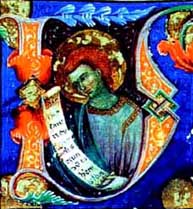TITLE PAGE
INTRODUCTION
GLAGOLITIC PAST
1483 MISSAL
BIBLIOGRAPHY
Illuminated initial in the Missal of Princ Novak, 1368, the text examplar for the 1483 Missal. The manuscript is now in the Austrian National Library, Vienna. Image from web page: Croatian glagolitic heritage ....
TEXT OF THE MISSAL
The altar missal is the book which contains the prayers said by the priest at the altar as well as all that is officially read or sung in connection with the offering of the holy Sacrifice of the Mass throughout the ecclesiastical year. To the book is prefixed with calendar and a systematized collection of rubrics for the guidance of priests. The Proprium de tempore is shorter and contains the liturgical texts which are said in every Mass. The Ordo Missae with the prefaces and the Canon, is placed near the center of the volume immediately before the Mass for Easter Sunday. The remainder of the book is devoted to those portions of the liturgy which vary from day to day according to feast and season. That is followed with the Masses of the season after which come a part with the Masses for the separate festivals (Proprium Sanctorum) in the ecclesiastical year, and as the conclusion comes the Common of Saints (Commune Sanctorum). This is supplemented by a certain number of votive Masses, among the rest Masses for the dead, and a collection of collects, secrets, and post-communions for special occasions. Here are inserted certain benedictions and other miscellaneous matter, while appendixes of varying bulk supply a number of Masses used in specific localities or in certain religious orders, and arranged according to the order of the calendar (from CATHOLIC ENCYCLOPEDIA).
Until the COUNCIL OF TRENT (1545-1563), the contents and the language of the missals varied widely across the western Christendom. However, after the confirmation of decisions of the Council by the pope Pius IV (1499-1565) in the year 1564, printing of all liturgical texts for the churches recognizing the Holy See was produced in Vatican’s De Propaganda Fide (1622), including the liturgical books in Glagolitic script (Fučić 1974, p. 11).
The 1483 Missale Romanum Glagolitice follows this standard order of missals: (1) calendar, (2) Proprium de tempore, (3) Ordo missae and conon, (4) votive masses for the dead (5) Proprium sanctorum, (6) Commune sanctorum and (7) ritual texts.
The language of the Missal is of the Croatian redaction of Old-Slavic, with strong influence of the local vernacular (čakavski dialect), in particular the areas of the Istrian peninsula. The text exemplar is mostly (but not exclusively) the manuscript know as the Missal of Prince Novak from 1368. This manuscript was written by the nobleman from the region of Lika and in 1405 was bought by the parishioners of church of St Jelena in village of Nugla (Istrian peninsula). Documents state that parish paid 45 golden pieces for the manuscript. The manuscript is today in the Austrian National Library in Vienna (signature Cod. Slav. 8), and have tantalizing marginal inscription from the year 1482 written by the local priest Jurij. On the margins, he noted something about the print (štampa). Because of vagaries of the dialect and abbreviation in the text it is unclear if he is talking about the moving of the printing shop somewhere (gori gre) or expressing joy at how well the printing is going (sentence begins with words Vita. Vita.).
The selection of the holidays of saints and martyrs in the calendar of the Missal is consistent with the region of Istria and northern part of the Adriatic coast. The peculiarity of this Missal is the holiday of the St. Jerome (Translatio s. Hieronymi) which does not appear in any other contemporary missal, Glagolitic or Latin. However it would further underline the Istrian redaction of the text, regarding that by the local legend St Jerome was born in Istria (Zrenj near Buzet) (Nazor 1993, p. 232) and is the creator of the Glagolitic script.
 PRINTING
PRINTING
 DESCRIPTION
DESCRIPTION
 TYPOGRAPHY
TYPOGRAPHY
 BINDING
BINDING
 COPIES
COPIES

Bibliography
Fučić, B. (1974). Uvez glagoljske knjige. Zbornik - Muzej primenjene umetnosti. 18, 5-12.
Nazor, A. (1993). Hrvatskoglagoljske inkunabule. U povodu 500. obljetnice brevijara Blaža Baromića (1493-1993). Croatica. Prinosi proučavanju hrvatske književnosti, XXIII/XXIV(37/38/39).
Written by Vlasta Radan.
Last update April 10, 2006.
